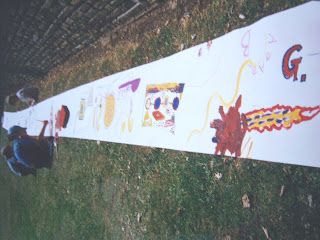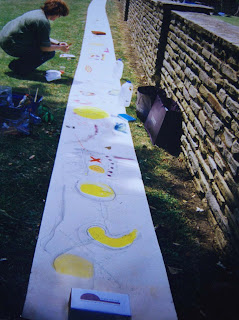....... intersubjective experiences and the risks of intersubjective engagements.....m-others
Wednesday, December 15, 2004
Thursday, September 2, 2004
The Big Draw -Drawing without borders
The Big Draw -Drawing without borders
Community project
Gladstone park
Dollis hill
Community project
Gladstone park
Dollis hill
 Drawing as always been the essence of most art forms. Since the beginnings of mankind it has always been the closest form to nature. It is another form of language to express nature, creativity, (creativity which comes from nature and what we see) and mankind.
Drawing as always been the essence of most art forms. Since the beginnings of mankind it has always been the closest form to nature. It is another form of language to express nature, creativity, (creativity which comes from nature and what we see) and mankind.

The Big Draw -Drawing without borders Community project
Drawing is the act of creating a representation of any subject by the use of lines and/or value. Most people associate drawing with pencils or charcoal, but a drawing can be made with any instrument that makes a mark. When some mediums are used to create a piece of art, the result is always considered a "drawing". Charcoal and graphite pencil are examples of these. Other mediums can be drawn "with" but the resulting artwork may or may not be considered a drawing. For example, art created with a computer can be either drawn or painted.
Drawing is considered to be the foundation of all other visual art forms. Drawing students learn how to observe line, form, texture, and value and then reproduce them realistically. Once these basic skills are mastered, they can be utilized in any other visual art medium.
While imaginative or fantasy drawing is creative, realistic drawing is the best way to learn basic art skills and even very young students can learn to draw in a realistic way if they are taught how. Most children, and most adults too, feel a profound sense of accomplishment when they draw any subject accurately. The skill required to draw realistically makes drawing from the imagination even more rewarding, too. It's easier to draw the dragon you see in your mind if you know how to draw scales and flames!
Drawing is very empowering and anyone, from about age eight and upward, can learn basic drawing skills. I encourage you to explore the drawing how-to's here at Toad Hollow, browse other drawing sites, and visit the art section of your library and check out a couple of drawing books. After you've got the basic skills under your belt, you can start drawing family, pets, places, and scenes you want to remember, and nothing captures a moment better than a drawing does.
From http://toadhollowstudio.com/drawing-directory/articles/article-1.html
Drawing is the act of creating a representation of any subject by the use of lines and/or value. Most people associate drawing with pencils or charcoal, but a drawing can be made with any instrument that makes a mark. When some mediums are used to create a piece of art, the result is always considered a "drawing". Charcoal and graphite pencil are examples of these. Other mediums can be drawn "with" but the resulting artwork may or may not be considered a drawing. For example, art created with a computer can be either drawn or painted.
Drawing is considered to be the foundation of all other visual art forms. Drawing students learn how to observe line, form, texture, and value and then reproduce them realistically. Once these basic skills are mastered, they can be utilized in any other visual art medium.
While imaginative or fantasy drawing is creative, realistic drawing is the best way to learn basic art skills and even very young students can learn to draw in a realistic way if they are taught how. Most children, and most adults too, feel a profound sense of accomplishment when they draw any subject accurately. The skill required to draw realistically makes drawing from the imagination even more rewarding, too. It's easier to draw the dragon you see in your mind if you know how to draw scales and flames!
Drawing is very empowering and anyone, from about age eight and upward, can learn basic drawing skills. I encourage you to explore the drawing how-to's here at Toad Hollow, browse other drawing sites, and visit the art section of your library and check out a couple of drawing books. After you've got the basic skills under your belt, you can start drawing family, pets, places, and scenes you want to remember, and nothing captures a moment better than a drawing does.
From http://toadhollowstudio.com/drawing-directory/articles/article-1.html
Thursday, July 1, 2004
My practice as an artist

Development of my art practice over the past several years has considerably
changed. I am always searching for different possibilities to develop
my work into something else
Often the importance is not the work itself but the original concept behind it.
The work usually happened during the process of working when
communication through images occur.
I try not to limit my imagination, I question, I look for ideas, I use my experience.
My work can be interpreted as an attempt to explore alternative ways and
issues of using traditional techniques as printmaking, painting, drawing,
combined with digital and multimedia arts.
Traditional and digital can be blended without undermining either of them.
A few years ago I took first steps towards migration from traditional image
towards digital. Now I go back and forward from traditional to digital and
vice versa, with constant change and transformation of creative energy into
something new and different.
What ever techniques I use I try to break boundaries, break the forms and
find new interpretations.

Having gained BA in Fine Art from LONDON INSTITUTE,
Central St. Martins College of Art and Design, gave me insight
of importance of conceptual thinking.
The importance is in analyzing and questioning relationship
between art theory and art practice without collapsing one or another.
Collaborating with other artists and general public, exhibiting my work
in the UK and abroad, also working as a lecturer in educational settings
enriched my experience as a practising artist.
.......

In the past I designed several workshops with unique approach to teaching and learning.
Thinking process, sharpening perception, letting creativity to flow
unrestricted, collecting and gathering visual materials, thinking about where do we look, how do we look, what do we see, how do we capture and
materialize ideas are the fundamental principals about this unique approach.
Friday, May 28, 2004
Subscribe to:
Posts (Atom)




